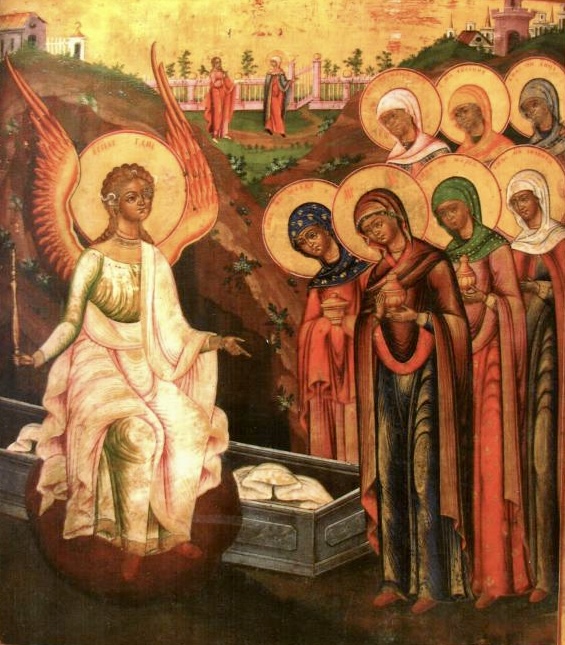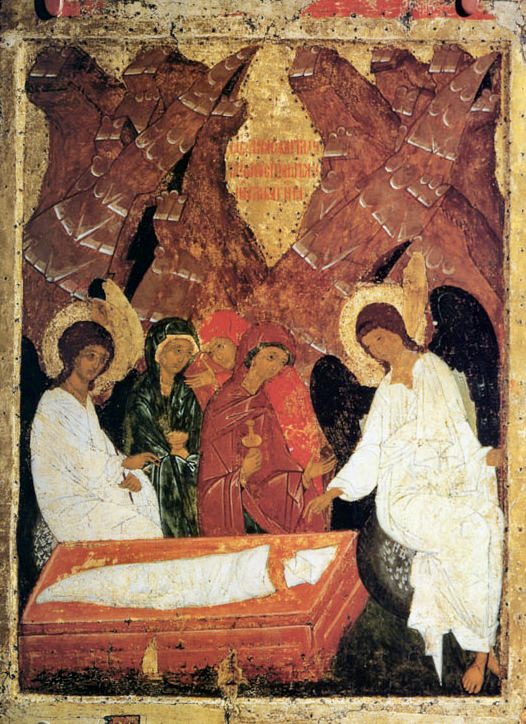“The myrrh-bearing women in the deep dawn stood before the tomb of the Giver of life; they found an angel sitting upon the stone, and he, speaking to them, said thus: Why seek ye the Living among the dead? Why mourn ye the Incorruptible amid corruption? Go, proclaim unto His disciples.”
In the Name of the Father, and of the Son, and of the Holy Spirit.
Dear brothers and sisters, Christ is Risen!

As we celebrate the Sunday of the Holy Myrrh-Bearers – Mary Magdalene, Mary the mother of James and Joses, Mary of Cleopas, Martha and Mary of Bethany, Joanna, Salome, Susanna – together with St Joseph of Arimathea and St Nicodemus, we encounter such enduring love and devotion for the Lord, which was not eclipsed by His outwardly ignominious death. This love and devotion continued, even though the Light had gone out in their lives and was replaced by confusion, spiritual and emotional darkness, fear and uncertainty
In the intended actions of the Myrrh-Bearers, we see the continued corporeal and loving concern for their Master in a continuation of their quiet but constant Gospel presence.
In the case of St Mary Magdalene, this is borne out by the fact that she is mentioned twelve times – more than anyone other than the apostles.
In his Gospel, St Luke, speaks of the material support given by several of those remembered by the Church as Myrrh-Bearing women:
“Soon afterwards he went on through cities and villages, proclaiming and bringing the good news of the kingdom of God. The twelve were with him, as well as some women who had been cured of evil spirits and infirmities: Mary, called Magdalene, from whom seven demons had gone out, and Joanna, the wife of Herod’s steward Chuza, and Susanna, and many others, who provided for them out of their resources.”
(Luke 8:1-3)
We have so recently commemorated the wonder of the raising of Lazarus, in whose home Mary and Martha, the Myrrh-Bearers, followed the Lord in their individual ways – Mary sitting attentively and contemplatively at His feet, and the ever-practical and busy Martha rushing around to provide for the Lord and the band of the disciples.
The world and lives of the Myrrh-Bearing women was Christocentric – living to serve the Lord, to enable His ministry, materially-providing for the preaching of the Gospel, and we are ALL indebted to them for their practical support for our Saviour’s ministry, in which they followed Him, providing and caring for Him and His disciples out of their own means (Mark 15:41).
Who was cooking, cleaning, washing, darning, mending… doing so many practical everyday things? Who was at the edges of the last Supper, though not appearing in the Gospel narrative?

As 21st century Christians and disciples, we still benefit from the support and labours of the women who enabled the Lord’s ministry, and we should be thankful to them even as we celebrate their memory.
In the dangerous days of Holy Week, after His arrest and during His trial and execution their faithfulness did not cease. Unlike the majority of the apostles, they did not flee, but rather stood by the Cross and then accompanied Him to His cursory, rushed burial in the Noble Joseph’s rock-hewn sepulchre.
What love and fearlessness devotion we see; what selflessness in ignoring danger and keeping vigil in the events of the passion and death of Christ; what faithfulness and loyalty, taking them all the way to the sepulchre, even though the disciples had fled in the darkness, confusion and fear that had descended upon the followers of the Lord.
But despite the fact that the Myrrh-Bearing women had not fled, the same darkness, confusion and fear must have gripped their lives, so soon after the events of Golgotha.
For them – whose lives had been shaped by their constant support for Christ and the disciples – that life was over, or rather nearly over, as they prepared their last physical act of love for the Master.
Jesus – the centre of their world and meaning of their daily existence – was dead; their world had fallen apart; they had lost hope.
We sing of this in the verses on ‘Lord, I have cried…’:
“The myrrh-bearing women came to Thy tomb; and beholding the seals of the sepulchre and not finding Thine immaculate Body, they came with haste, lamenting and saying: Who hath stolen our Hope?”
This is also seen in the doxastikon of the vespers aposticha, in the poetic voice of Joseph of Arimathia, who presided over the burial after begging His body from Pilate:
“O Thou Who puttest on light like a garment, when Joseph with Nicodemus took Thee down from the Tree, and beheld Thee dead, naked, and unburied, he struck up a compassionate dirge, and with mourning he said: Woe is me, O sweetest Jesus! When but a short while ago the Sun beheld Thee hanging upon the Cross, it shrouded itself in darkness, and the earth quaked with fear, and the veil of the Temple was rent asunder, But, behold, now I see Thee willingly submitting to death for my sake. How shall I bury Thee, O my God? Or how shall I wrap Thee with winding sheets? With what hands shall I touch Thine undefiled Body? Or what dirges shall I sing at Thy departure, O Compassionate One?”
However, the very fact that the women came through the darkness of that first Paschal morning bearing sweet aromatics shows that though life as they knew it was over, their love and devotion endured, and the sacred final demonstration of this had to be performed and fulfilled.
But, though this love and devotion survived, hope had indeed vanished as they worried about how they would even gain access to the tomb with the great stone blocking the entrance. The physical darkness of that pre-dawn was an outer sign of the inner darkness that must have enveloped them when their Light was extinguished on the Cross.
How confusing and nonsensical this must have seemed, after all they had witnessed – miracles, healings, the blind made to see, the deaf to hear, the lame to walk, lepers made clean, and not only the recently dead raised up, but even the raising of Lazarus – a four days dead decomposing corpse!
For those who saw Jesus, heard Jesus, fed Jesus… treasured every hour and day in His presence, how could anything make sense anymore?
The matins canon asks,
“Who is it that withered the fig tree? Who is it that healed the withered hand? Who is it that once filled the multitude in the wilderness? Is it not Christ God, Who raised up the dead?
Who is it that raised from the grave, the man four-days dead, and the son of the widow? Who is it that, as God, strengthened the paralytic on his bed? Is it not Christ God, Who raised up the dead?”
… and the Myrrh-Bearers must surely have ben reflecting on these self-same wonders, trying to reconcile them with the expectation of the Lord’s dead and lifeless corpse in the Arimathean’s tomb.
Can we, who celebrated the Resurrection in the dark hours of Pascha night knowing what they didn’t know, even begin to understand their pain, their loss, their confusion and the darkness that had swallowed their world as the Light of the World seemed to have set for ever?
We celebrated the solemn and saving events of Holy Week – with the Saviour’s arrest, trial, torture, humiliation, crucifixion, death and burial – already knowing the joyful reality that the Myrrh-Bearers didn’t discover until the revelation of the Resurrection at the garden-tomb, and even though filled with compunction and sadness in our commemoration of the events of the Great and Holy Week, we did so with the joyous foreknowledge of the Resurrection. They did not!
We started the celebration of their annual Paschal memorial and their dawn-discovery by singing ‘Christ is Risen from the dead…’, but as they journeyed through the darkness to the sealed-tomb, they had no knowledge of the wonder that awaited them.
 They had every excuse to be confused, fearful, anxious, enveloped in mental, spiritual darkness, but what of us, who have just celebrated the Saviour’s Victory over hell and death?
They had every excuse to be confused, fearful, anxious, enveloped in mental, spiritual darkness, but what of us, who have just celebrated the Saviour’s Victory over hell and death?
We allow ourselves to be ground-down, depressed, tortured and crushed by aspects of our lives that envelope us in blackness, despite our knowledge that ‘Christ is Risen!’
This is not to trivialise the real trials and anguish that so many face, but we must face and conquer these trials, tribulations and temptations in the knowledge of Christ’s Victory and Life-Giving Resurrection, and that the temporal world will itself give way to the Eternal Pascha of the Eighth Day of the Kingdom of God in the age to come.
We must remember that despite the agony and trials of the Myrrh-Bearers, they have become our teachers as the first witnesses and announcers of the Resurrection – the bearers of the miraculous and wondrous news, despite the fact they had initially lost hope.
LOVE remained burning within them, and it was this enduring love that was the context in which hope was restored and reborn: not a fleeting sensation or feeling of hope, but an enduring and eternal hope for all generations – hope that is a person, a person Who is both God and man: our personal hope that is the Risen Christ, the Conqueror of Death.
Love made the Myrrh-Bearers risk danger to do what their love for Christ demanded – even as the disciples hid in a locked house, not showing the courage and dutiful devotion of the Myrrh-Bearing women.
“Retaining love in their hearts for God, they received infinitely more than what they hoped for, both for themselves and for all their loved ones both living and dead.”
Metropolitan Tikhon of Pskov
… and it is in persevering in love for God, in dutiful devotion like the Myrrh-Bearers, and imitating them, that we can rediscover hope in the Victory of the Lord’s Resurrection and the Radiant Joy of Pascha – whatever the day, the month, the hour.
We do not declare that Christ HAS risen, as a past event, way back in time… rather, we always declare that Christ IS risen. And in this reality we find ETERNAL HOPE, and if we remain steadfast in loving God, whatever trials, anxieties, fears and trials beset us – there is always hope.
The Myrrh-bearers had reason to have lost hope, but as children of the Church, baptised into the Lord’s death and resurrection, we do not.
The loyal and dutiful servants of the Risen Lord, the Holy Myrrh-Bearers went into the dawn bearing the sweet scented myrrh of love and devotion to their Lord.
Let us go into the world as hope-bearers, carrying the life-transforming hope that they rediscovered as they cast aside the needless perfumes they bore, as Christ the Sun of Righteousness rose again in their lives.
Christ did not need the myrrh they brought, but in the message of the Resurrection, the world desperately needs the HOPE that we must bear and joyously announce for the world to hear – the message of the Eternal Pascha and that Christ is risen!
Amen!